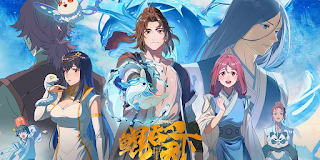⚔️ Dororo – War, Demons & the Human Heart
⚔️ Dororo – War, Demons & the Human Heart
by Silenced Artworks
When most people think of a samurai story, they picture stoic warriors trading steel beneath cherry blossoms. Dororo takes that image, rips the blossoms off the branch and feeds them to a hungry demon. Part historical drama, part dark fantasy, Osamu Tezuka’s 1960‑s manga – and, even more so, its 2019 television reboot – asks a brutal question: what would you give up for power, and what will it cost to win it back?
A Cursed Birth & a Thief’s Tag‑Along
Long before the opening credits roll, feudal lord Daigo Kagemitsu has struck a deal with hell. Twelve (originally forty‑eight) demons take his first‑born’s body parts; in exchange Daigo’s lands thrive. The limbless, sightless baby is set adrift – only to be rescued by a compassionate doctor who outfits the child with lethal prosthetics and names him Hyakkimaru.
Years later, Hyakkimaru roams war‑scarred provinces, slaying each demon that stole a piece of him. He’s joined by Dororo, a street urchin who steals, swears and hides a secret under their ragged clothes. One wants his body back; the other just wants a full stomach – yet together they carve a bloody trail toward something like family.
Why Dororo Still Feels Fresh in 2025
1. The Reverse Hero’s Journey
Most protagonists grow stronger; Hyakkimaru literally becomes weaker each time he regains a limb or sense. Feeling pain, hearing screams and bleeding for the first time make victory bittersweet – and horrifyingly human.
2. A Ground‑Level View of War
Rather than romanticizing Sengoku‑era battles, the series fixates on peasants whose fields burn, children orphaned by passing armies, and soldiers who’d rather desert than die for a lord’s ambition. It’s anti‑war without preaching.
3. Gender & Identity Layers
Dororo presents as a boy while canonically female – a reveal handled with surprising grace for both 1960s source material and modern anime. The show never lets gender eclipse agency; Dororo is defined by grit, not biology.
Quick comparison:
1969 TV Series — Mushi Production; director Gisaburō Sugii; 26 black‑and‑white episodes; tone: pulp “yōkai‑of‑the‑week” adventure; available on Discotek DVD (North America).
2019 TV Reboot — MAPPA × Tezuka Productions; director Kazuhiro Furuhashi (Rurouni Kenshin: Trust & Betrayal); 24 widescreen HD episodes; tone: gritty, character‑driven tragedy; streaming on Amazon Prime Video worldwide and on Sentai Blu‑ray.
MAPPA’s 2019 run replaces Tezuka’s cartoonish demons with grotesque, painterly nightmares and gives Hiroyuki Asada’s character sheets a muted wash of earth and blood. Dororo isn’t afraid of stillness – rain on a broken Buddha, the hush before a prosthetic arm unsheathes its hidden katana – and when violence erupts, it’s swift and brutal. Composer Yoshihiro Ike scores each reclaimed heartbeat with taiko booms and elegiac strings, making victories triumphal and tragic all at once.
Characters Who Bleed Off the Screen
-
Hyakkimaru – Stoic, almost feral ronin whose humanity grows with every lost advantage. Watching him learn to hear rain or cry for the first time will wreck you.
-
Dororo – Mouthy thief, moral compass and occasional conscience. Their optimism slices through despair harder than Hyakkimaru’s arm‑blade.
-
Tahōmaru – The healthy younger brother raised to rule; his arc from proud heir to desperate rival mirrors Hyakkimaru’s ascent in reverse.
-
Nui no Kata – The boys’ mother, torn between two sons and a pact she never chose, embodies the show’s lament: every deal with the devil bankrupts the innocent first.
Personal Impressions
I expected monster‑of‑the‑week catharsis. What I got was an existential gut‑punch wrapped in ukiyo‑e aesthetics. The 2019 adaptation’s willingness to linger – on a widow’s silent scream, on Hyakkimaru trembling as pain registers for the first time – makes each reclaimed organ feel like both a gift and a curse. Dororo’s foul‑mouthed hope balances the bleakness, and the finale’s moral stalemate lands harder than any final boss decapitation.
Final Verdict
Watch it if you crave samurai action with a philosophical core. Avoid it only if child endangerment or body horror is a hard pass.
🎬 Production Notes (2019 Series)
-
Studio: MAPPA × Tezuka Productions
-
Director: Kazuhiro Furuhashi
-
Series Composition: Yasuko Kobayashi (Attack on Titan, JoJo’s Bizarre Adventure)
-
Character Design: Hiroyuki Asada & Satoshi Iwataki
-
Music: Yoshihiro Ike
-
Opening Theme: “Kaen” by Queen Bee
-
Ending Theme: “Sayonara Gokko” by amazarashi
-
Streaming: Amazon Prime Video (sub & dub)
-
Physical Release: Sentai Filmworks Blu‑ray + English dub
📚 Beyond the Anime
-
Original Manga – Vertical omnibus (Eisner Award winner).
-
The Legend of Dororo & Hyakkimaru – Ongoing manga retelling by Satoshi Shiki (Seven Seas).
-
Live‑Action Film (2007) – Worth a curiosity watch for Weta‑Workshop prosthetics and New Zealand landscapes.
-
PS2 Game: Blood Will Tell – Cult classic hack‑and‑slash; fight all forty‑eight demons if you want the true ending.




Comments
Post a Comment